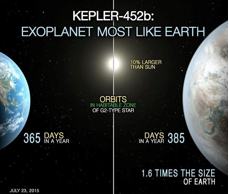Science Seen Physicist and Time One author Colin Gillespie helps you understand your world.
Near Earths Other Earthlike Planets in the Milky Way
There’s a planet in the news. An international team of astronomers using NASA’s Kepler spacecraft has spotted the most Earth-like extrasolar planet ever found. Seeking Earth-like planets is what Kepler’s all about. Indeed thanks in large part to Kepler new planets are old hat these days. The first confirmed discovery was 27 years ago. Around 2,000 are now known. And the latest, called Kepler-452b, is one of seven Earth-like planets Kepler’s found so far this year.
Many extrasolar-planet finds are gas giants like Jupiter. They are relatively easy to detect. But of course what is most wanted is a smaller, solid planet that can support life, a planet much like ours: a five- to twenty-thousand-mile-wide rock a hundred-million miles or so from a nice star. Now we’ve got one. Good for NASA. But what does it tell us? 
Well, on the face of it, not much that we didn’t know already. We’ve found ten planets that are more Earth-like than Venus is. Lead melts in the shade on Venus these days, but billions of years ago—before the greenhouse gases took control—its climate was more Earth-like. Kepler-452b could have a similar heat problem but it’s fun to find a planet that is more or less like ours. Its year is 385 of our days. Its gravity may be twice Earth’s. Its star, Kepler-452, is one third older and a little bigger than our Sun. It gives off more heat but is a tad more distant. Absent a greenhouse-gas effect, 452b could be so similar to Earth that humans just might learn to feel at home. However, we won’t get to try. Kepler-452 is 1,400 light years away.
A planet like 425b was sure to show up soon and more are sure to be around the corner. Their rarity to date is mostly due to detection limitations. In 2013 three American astronomers found that current search-technology misses most Earth-sized planets, especially those whose year is as long as ours. They extrapolated other data to show about one in sixteen Sun-like stars has a roughly Earth-sized planet with a year like ours. As technology improves we’ll find them.
As we find more, and find out more about them, we get more grist for the guessing mill: How many of the hundreds of billions of planets orbiting stars in the Milky Way are suitable for life? We are still guessing. But as discoveries like 425b come in along with other data our guesses are getting better. One way to express that guess is: one in twenty-five of its about two-hundred-and-fifty billion stars has a maybe-life-supporting planet. That’s about ten billion.
How many of those planets that can support life do in fact have life forms on them? So far we have no data on this question, or rather we have a single datum, Earth. How to extrapolate it is anybody’s guess. Which leads to more news: with Stephen Hawking on tow, Russian entrepreneur Yuri Milner has placed a hundred-million-dollar bet on that.
One could also think about the other galaxies within the part of the universe that we can see; their number’s reckoned as about a hundred billion. That leads to an estimated billion-trillion life-supporting planets. This number is so vast that, as I guesstimated in another post, the expansion of the universe whisks thousands of them per second forever from the space that we can see. It’s a far-flung projection from the little that we know. But that’s life.
Sources:
Jon Jenkins et al. (2015), “DISCOVERY AND VALIDATION OF Kepler-452b: A 1:6-EARTH-DIAMETER SUPER EARTH EXOPLANET IN THE HABITABLE ZONE OF A G2 STAR”, AJ, Bristol UK: IOP Publishing, vol. 150, p. 56; https://www.nasa.gov/sites/default/files/atoms/files/ms-r1b.pdf
Other Materials:
Erik Petigura et al. (2013), “Prevalence of Earth-size planets orbiting Sun-like stars”, Proc. N.A.S. USA, vol. 110, p. 19273; http://arxiv.org/abs/1311.6806
Colin Gillespie (2013), Time One: Discover How the Universe Began, New York: RosettaBooks, p. 98, http://www.rosettabooks.com/book/time-one/; “The Disappearing Universe”, http://www.timeone.ca/chapters/the-disappearing-universe.pdf
Image credit: NASA, http://www.nasa.gov/image-feature/soaking-up-the-rays-of-a-sun-like-star-artistic-concept

No comments yet.